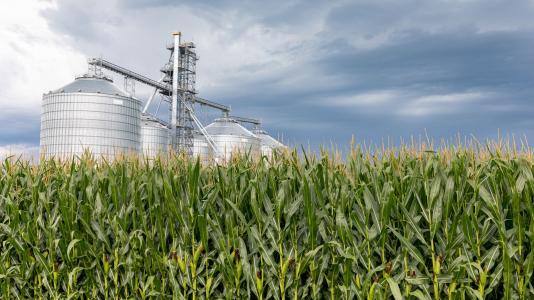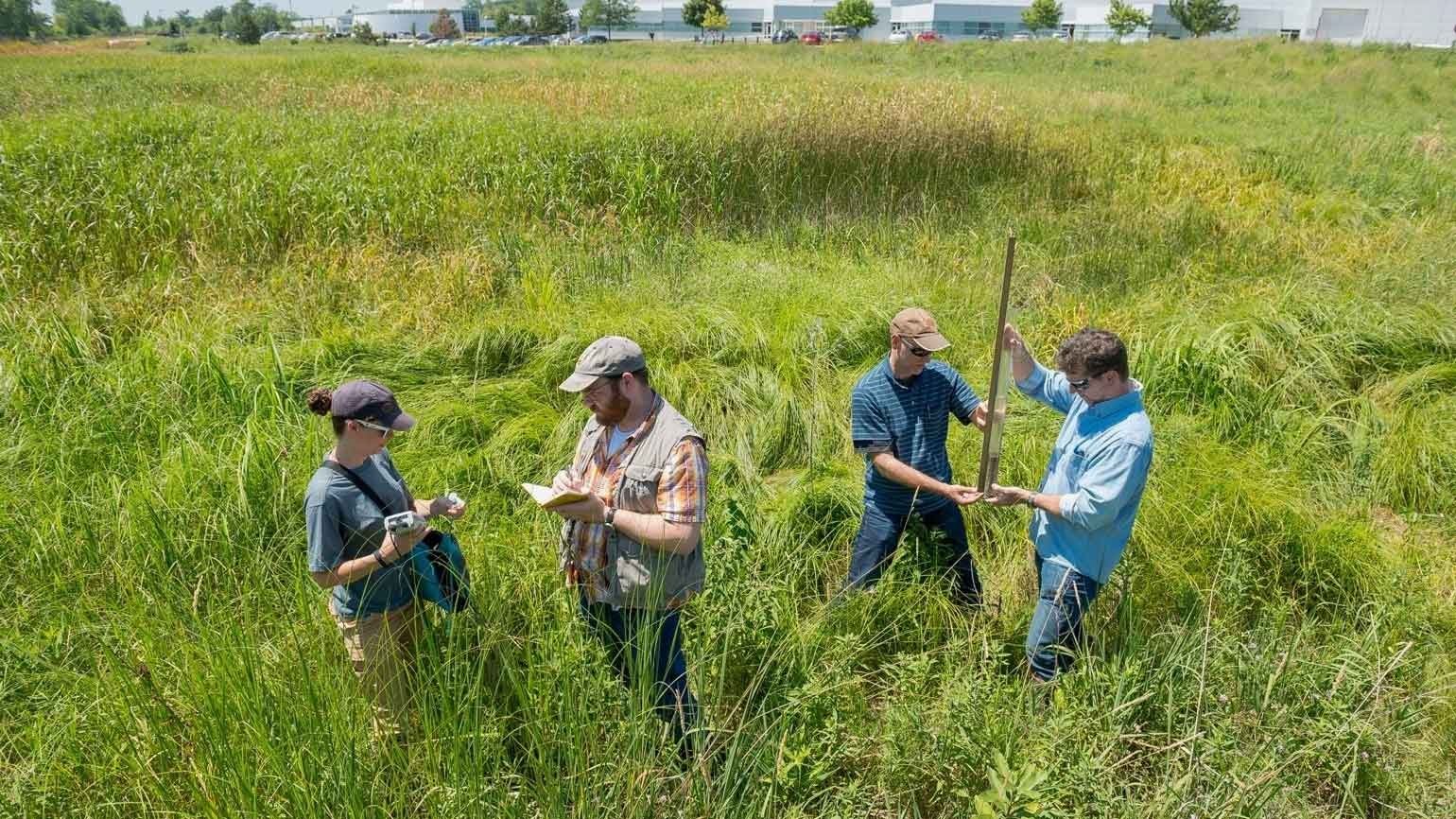The eBERlight program aims to connect the world-leading X-ray facility with more scientists studying Earth’s climate, environment and bioeconomy crops.
BY ANDRE SALLES | SEPTEMBER 21, 2023
 The Earth is a complex ecosystem, and our place in it is dependent on many different factors. From soil health to air quality to the behavior of plants and microorganisms, understanding our natural world and its other inhabitants is vital to our own survival. As the climate continues to change, research into the environment and its diverse forms of life will only become more important.
The Earth is a complex ecosystem, and our place in it is dependent on many different factors. From soil health to air quality to the behavior of plants and microorganisms, understanding our natural world and its other inhabitants is vital to our own survival. As the climate continues to change, research into the environment and its diverse forms of life will only become more important.
In October 2023, the Advanced Photon Source (APS), a U.S. Department of Energy (DOE) Office of Science user facility at DOE’s Argonne National Laboratory, will officially launch a new initiative to expand biological and environmental research at the world leading X-ray and analysis facility. The enterprise, dubbed eBERlight, recently received approval from DOE’s Biological and Environmental Research (BER) program. Its goal is to connect researchers conducting experiments within the BER mission with the world-leading X-ray science resources of the APS. By increasing access to multiple capabilities at the APS, the minds behind eBERlight hope to find new scientific approaches and engage new groups of multidisciplinary researchers towards investigating new insights about the world in which we live.
“This is an opportunity to build something new that, until now, hasn’t existed at APS,” said Karolina Michalska, a protein crystallographer at Argonne who is leading the eBERlight effort. “We’re broadening the access to accommodate more biological and environmental research, and since this program is so new, the scientists who will use the facility are helping us to develop it.”
The APS has been a leader in one area of biological research, called macromolecular crystallography, since the facility’s inception in the 1990s. Scientists have used this technique to learn more about infectious diseases and viruses to help lay the groundwork for vaccines and treatments. Now the APS is looking to expand its successes into other areas of life and environmental sciences.
One challenge with this expansion is that many scientists in biological and environmental fields are unaware of the capabilities at APS that can help them advance their research and aren’t familiar with the process for gaining access to the facility’s bright X-ray beams. Similarly, many of these scientists don’t know which of the APS’s many experiment stations — called beamlines — would be the best choice for their experiments, since each one is optimized for particular scientific techniques.
This is where eBERlight comes in, according to Michalska. She describes it as a virtual ecosystem geared toward connecting scientists with the right techniques at the right APS beamlines. Researchers will send in proposals to the eBERlight staff, who will assist in matching experimental designs with the right beamlines to carry out the proposed research. The varied capabilities of the APS, she said, means that eBERlight can have an impact across the spectrum of biological and environmental science.
“We are learning what BER researchers are studying and how we can complement that research,” she said. “Some of these researchers have never used a synchrotron such as the APS. They are learning what tools they can access, and what science can be addressed at the APS that you can’t do elsewhere.”
As for the specific science eBERlight will facilitate, Michalska said it will include everything from soil studies to plant growth to cloud formation to biofuels. Stefan Vogt, associate director of the X-ray Science division at the APS, adds water cycles to the list, noting that this information is vital to better understand changing climate conditions.
“We have always worked on questions related to climate science, and need to continue to work on them,” Vogt said. “We need to understand how to deal with the profound impact of a changing climate on the environment.”
While eBERlight officially launches in October, the APS will still be in the middle of a year-long pause in operations, part of a comprehensive upgrade to the facility. During that time the team will be working on research and development at the beamlines for biological and environmental samples, developing its database and conducting outreach about the program.
When the APS begins operating again in 2024, its capabilities will be greatly expanded. The eBERlight team will have standing agreements with 13 APS beamlines, representing a broad range of techniques. Scientists working through eBERlight will also be able to use Argonne resources such as the Argonne Leadership Computing Facility, a DOE Office of Science user facility and home of the lab’s supercomputers, and the Advanced Protein Characterization Facility, where proteins are crystallized and prepared for analysis.
 As the program grows, it will leverage ties to other DOE Office of Science user facilities, such as the Environmental Molecular Science Laboratory at Pacific Northwest National Laboratory and the Joint Genome Institute at Lawrence Berkeley National Laboratory
As the program grows, it will leverage ties to other DOE Office of Science user facilities, such as the Environmental Molecular Science Laboratory at Pacific Northwest National Laboratory and the Joint Genome Institute at Lawrence Berkeley National Laboratory
“It takes a village to raise kids, but it takes a larger village to solve one science problem,” said Zou Finfrock, an Argonne physicist who is part of the eBERlight team. “I like eBERlight’s multifaceted nature as it strives to establish an integrated platform that fosters scientific exploration across biological, earth and environmental systems. It sounds simple, but the scope, and potential impact, is huge.”
The idea for eBERlight has been in the works for years, said Ken Kemner, a senior physicist and group leader at Argonne. Kemner has been with the lab for the entire 27-year life of the APS, and for much of that time he’s been working to connect environmental researchers with the facility’s resources. Now, he said, eBERlight will continue this work on a much larger scale. He’s excited to see what new breakthroughs will be made through research into greenhouse gases, wetland ecosystems and the interface of plants and microorganisms with soils and sediments.
The key to eBERlight’s success, Kemner said, will be education of both the synchrotron scientists and the biological and environmental scientists.
“You have to educate X-ray scientists to better understand environmental science questions and adapt the techniques to better serve environmental research questions,” he said. “You also have to educate environmental scientists on how great light source facilities are for addressing these questions. It’s about lowering that barrier bordering them.”
The new program means democratizing access to the APS and its capabilities, said Laurent Chapon, associate laboratory director for Photon Sciences and director of the APS.
“This program sends a vital message, that the APS is a key resource to the nation, able to develop programs to help tackle pressing issues, in this case in environmental and biological challenges,” Chapon said. “eBERlight will offer an end-to-end solution for scientists seeking to tackle natural science with real-world implications.”
Michalska agrees and is eager to get started.
“I hope that whatever grand challenges scientists take on, the APS can help them,” she said. “These challenges affect every one of us.”
For more information on the eBERlight program, please email eberlight@anl.gov.
____________________________________________
The Argonne Leadership Computing Facility provides supercomputing capabilities to the scientific and engineering community to advance fundamental discovery and understanding in a broad range of disciplines. Supported by the U.S. Department of Energy’s (DOE’s) Office of Science, Advanced Scientific Computing Research (ASCR) program, the ALCF is one of two DOE Leadership Computing Facilities in the nation dedicated to open science.
About the Advanced Photon Source
The U. S. Department of Energy Office of Science’s Advanced Photon Source (APS) at Argonne National Laboratory is one of the world’s most productive X-ray light source facilities. The APS provides high-brightness X-ray beams to a diverse community of researchers in materials science, chemistry, condensed matter physics, the life and environmental sciences, and applied research. These X-rays are ideally suited for explorations of materials and biological structures; elemental distribution; chemical, magnetic, electronic states; and a wide range of technologically important engineering systems from batteries to fuel injector sprays, all of which are the foundations of our nation’s economic, technological, and physical well-being. Each year, more than 5,000 researchers use the APS to produce over 2,000 publications detailing impactful discoveries, and solve more vital biological protein structures than users of any other X-ray light source research facility. APS scientists and engineers innovate technology that is at the heart of advancing accelerator and light-source operations. This includes the insertion devices that produce extreme-brightness X-rays prized by researchers, lenses that focus the X-rays down to a few nanometers, instrumentation that maximizes the way the X-rays interact with samples being studied, and software that gathers and manages the massive quantity of data resulting from discovery research at the APS.
This research used resources of the Advanced Photon Source, a U.S. DOE Office of Science User Facility operated for the DOE Office of Science by Argonne National Laboratory under Contract No. DE-AC02-06CH11357.
Argonne National Laboratory seeks solutions to pressing national problems in science and technology. The nation’s first national laboratory, Argonne conducts leading-edge basic and applied scientific research in virtually every scientific discipline. Argonne researchers work closely with researchers from hundreds of companies, universities, and federal, state and municipal agencies to help them solve their specific problems, advance America’s scientific leadership and prepare the nation for a better future. With employees from more than 60 nations, Argonne is managed by UChicago Argonne, LLC for the U.S. Department of Energy’s Office of Science.
The U.S. Department of Energy’s Office of Science is the single largest supporter of basic research in the physical sciences in the United States and is working to address some of the most pressing challenges of our time. For more information, visit https://energy.gov/science.
